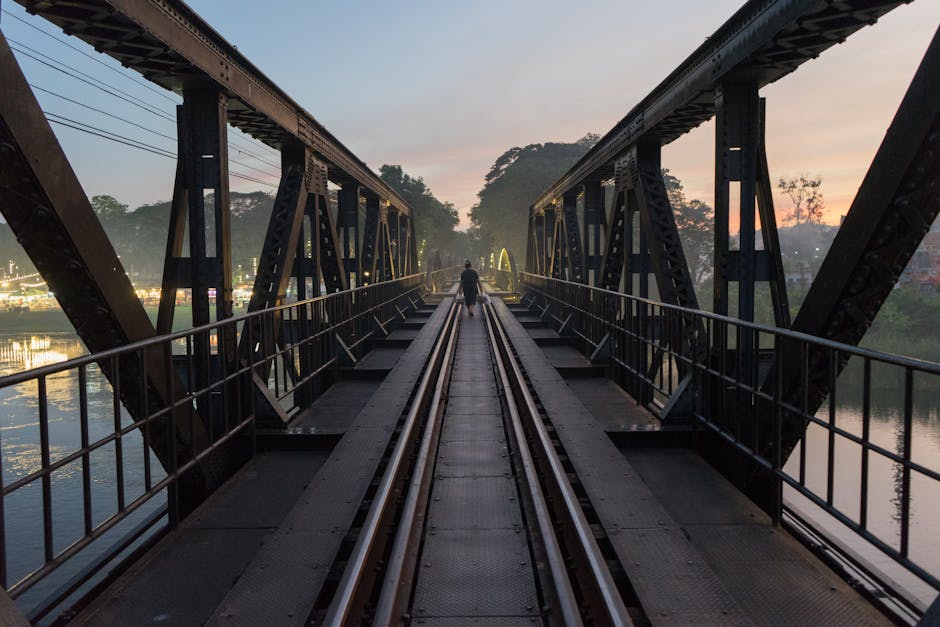The Bridge on the River Kwai: A Journey Through History in Kanchanaburi

The Bridge on the River Kwai: A Journey Through History in Kanchanaburi
Hey there, fellow history buff! Ever dreamt of stepping back in time, to a place where echoes of the past still resonate? Well, let me tell you about my unforgettable trip to Kanchanaburi, Thailand, a place forever linked to the poignant story of the Bridge on the River Kwai. It's more than just a tourist destination; it's a powerful reminder of human resilience, sacrifice, and the devastating impact of war.
A Date with History: Why Kanchanaburi?

Kanchanaburi, nestled amidst lush landscapes and serene rivers, offers a tranquil escape from the bustling city life. But beneath the idyllic scenery lies a compelling, sometimes heartbreaking, historical narrative. I've always been fascinated by World War II history, and the story of the Bridge on the River Kwai, as popularized by the novel and film, had always intrigued me. I wanted to see it for myself, to understand the real story behind the fictionalized account, and to pay my respects to those who suffered and perished during its construction.
So, I packed my bags, booked my flights, and set off on an adventure to unravel the history woven into the very fabric of this remarkable province. And trust me, it didn't disappoint. It was an emotional rollercoaster, from the haunting silence of the cemeteries to the sheer engineering marvel of the bridge itself.
Delving into the True Story: Beyond the Hollywood Glitz

Okay, let's clear something up right away. While the movie "The Bridge on the River Kwai" (1957) is a cinematic masterpiece, it's important to remember it's a fictionalized version of events. The core of the story – the forced labor, the brutal conditions, and the unwavering spirit of the prisoners – remains true. However, the specifics, the characters, and the overall narrative are heavily dramatized for cinematic effect. The bridge in the film wasn't even the real bridge! It was built in Sri Lanka for filming.
The real story revolves around the Burma Railway, also known as the Death Railway. During World War II, the Japanese Imperial Army needed a reliable supply route to support their forces in Burma (now Myanmar). Sea routes were vulnerable to Allied attacks, so they decided to build a railway connecting Thailand and Burma through treacherous terrain.
Here's where the tragedy unfolds. The Japanese conscripted approximately 60,000 Allied prisoners of war (POWs), including British, Australian, Dutch, and American soldiers, along with an estimated 200,000 Southeast Asian laborers. They were forced to work under horrific conditions: inadequate food and medical supplies, grueling labor, and relentless brutality from their captors. Disease, starvation, and exhaustion were rampant. The construction of the railway, and particularly the bridge, was a monumental feat of engineering achieved at an unimaginable human cost.
Visiting the Key Historical Sites: My Personal Experience

My journey through Kanchanaburi was a somber yet enlightening experience. Here are some of the key sites I visited, and what I learned from each one:
- The Bridge on the River Kwai: Standing on the bridge itself, I was struck by its imposing presence. It's a working railway bridge, so you can even take a train ride across it! Walking along the tracks, I tried to imagine the scene during its construction – the endless lines of emaciated prisoners, the sounds of hammers and shouting, the constant threat of disease and death. It was a truly humbling experience. While parts of the bridge were bombed during the war, they've been rebuilt, and you can clearly see the sections that are original versus the rebuilt portions. It serves as a stark reminder of the horrors of war and the resilience of the human spirit.
- JEATH War Museum: JEATH stands for Japan, England, America/Australia, Thailand, and Holland – the nationalities involved in the construction of the railway. This museum, housed in a replica POW camp, offers a grim but essential glimpse into the daily lives of the prisoners. The exhibits include photographs, drawings, and personal artifacts that tell harrowing stories of hardship, suffering, and survival. Seeing the makeshift tools and meager belongings of the POWs really brought the human cost of the railway to life. It's a powerful and moving experience that underscores the importance of remembering this dark chapter in history.
- Kanchanaburi War Cemetery: This meticulously maintained cemetery is the final resting place for nearly 7,000 Allied POWs who died during the construction of the Burma Railway. Walking through the rows of white headstones, each bearing a name, age, and sometimes a poignant message, was an incredibly emotional experience. The sheer scale of the cemetery is a testament to the immense loss of life. It's a place for quiet reflection and remembrance, a reminder of the devastating consequences of war. I spent a long time there, reading the inscriptions and trying to imagine the lives of the young men buried there.
- Thailand-Burma Railway Centre: This is a museum and research center dedicated to documenting the history of the Burma Railway. It offers a comprehensive overview of the project, from its conception to its devastating consequences. The museum features interactive exhibits, photographs, and personal accounts that provide a deeper understanding of the railway's impact on both the POWs and the local communities. I found the research section particularly fascinating, as it provided access to original documents and firsthand accounts that shed new light on the events surrounding the construction of the railway.
- Hellfire Pass Memorial Museum: Located a few hours outside of Kanchanaburi, Hellfire Pass (also known as Konyu Cutting) is one of the most notorious sections of the Burma Railway. It's a deep rock cutting that was carved out by hand by the POWs under extremely harsh conditions. Visiting Hellfire Pass is a physically and emotionally challenging experience. Walking along the trail, you can see the sheer scale of the cutting and imagine the backbreaking labor that went into its construction. The museum provides valuable context and insights into the suffering endured by the POWs at Hellfire Pass. There is also an audio tour available, allowing you to walk through the site and hear firsthand accounts of the prisoners and laborers who were forced to work there. It's a truly unforgettable experience.
The Enduring Legacy: Lessons Learned

My trip to Kanchanaburi was more than just a sightseeing tour; it was a journey of discovery and reflection. I learned a great deal about the history of the Bridge on the River Kwai, the Burma Railway, and the experiences of the POWs and laborers who were forced to work on the project. But perhaps more importantly, I gained a deeper appreciation for the human cost of war and the importance of remembering the past.
Here are a few key takeaways from my experience:
- The importance of historical accuracy: While the movie "The Bridge on the River Kwai" is a compelling story, it's essential to remember that it's a fictionalized account. It's crucial to seek out accurate information and firsthand accounts to gain a true understanding of the events surrounding the construction of the Burma Railway.
- The human cost of war: The construction of the Burma Railway was a monumental tragedy that resulted in the deaths of tens of thousands of people. It's important to remember the suffering and sacrifice of the POWs and laborers who were forced to work on the project.
- The resilience of the human spirit: Despite the horrific conditions they faced, the POWs and laborers demonstrated incredible resilience and courage. Their stories of survival and resistance are an inspiration to us all.
- The importance of reconciliation: While it's important to remember the past, it's also essential to work towards reconciliation and understanding. By learning from the mistakes of the past, we can create a more peaceful and just future.
Planning Your Trip: Practical Tips and Advice

If you're planning a trip to Kanchanaburi to explore the history of the Bridge on the River Kwai, here are a few practical tips and advice to help you make the most of your experience:
- Best Time to Visit: The best time to visit Kanchanaburi is during the dry season, which runs from November to April. The weather is generally sunny and pleasant during this time, making it ideal for exploring the historical sites and enjoying the outdoor activities.
- Getting There: Kanchanaburi is easily accessible from Bangkok by bus or train. The bus is the most convenient option, with frequent departures from Bangkok's Southern Bus Terminal. The train is a more scenic option, but the journey is longer and the trains can be unreliable.
- Accommodation: Kanchanaburi offers a wide range of accommodation options, from budget-friendly guesthouses to luxurious resorts. Many hotels and guesthouses are located along the river, offering stunning views of the Bridge on the River Kwai.
- Transportation: Once you're in Kanchanaburi, you can get around by tuk-tuk, taxi, or rented motorbike. Tuk-tuks are a fun and convenient way to explore the town, but be sure to negotiate the fare before you start your journey. Renting a motorbike is a good option if you want to explore the surrounding countryside at your own pace.
- What to Wear: Dress respectfully when visiting the historical sites, particularly the war cemeteries and museums. Avoid wearing revealing clothing and be sure to remove your shoes before entering any religious buildings.
- Food and Drink: Kanchanaburi offers a wide variety of delicious Thai food. Be sure to try some of the local specialties, such as river prawns and grilled fish. There are also plenty of restaurants serving international cuisine.
- Be Prepared for Emotion: Visiting these sites can be emotionally draining. Allow yourself time to process what you're seeing and feeling. It's okay to feel sad or overwhelmed.
Beyond the Bridge: Exploring Kanchanaburi's Other Treasures

While the Bridge on the River Kwai is undoubtedly Kanchanaburi's most famous attraction, the province offers so much more to explore. Here are a few other highlights that you might want to consider adding to your itinerary:
- Erawan National Park: This stunning national park is home to the seven-tiered Erawan Falls, one of the most beautiful waterfalls in Thailand. The park also offers hiking trails, caves, and opportunities for swimming and wildlife spotting.
- Sai Yok National Park: Another beautiful national park, Sai Yok is home to the Sai Yok Yai Waterfall, which flows directly into the River Kwai. The park also offers opportunities for trekking, camping, and kayaking.
- Prasat Muang Sing Historical Park: This ancient Khmer temple complex dates back to the 13th century. The park offers a fascinating glimpse into the history of the Khmer empire in Thailand.
- Mueang Sing Historical Park: Featuring well-preserved Khmer ruins, this park provides a glimpse into ancient Khmer architecture and history.
- Floating Markets: Experience the vibrant atmosphere of a traditional Thai floating market. Sample local delicacies, shop for souvenirs, and enjoy the lively atmosphere.
Final Thoughts: A Journey of Remembrance

My trip to Kanchanaburi was a profound and moving experience. It was a journey through history, a tribute to the human spirit, and a reminder of the devastating consequences of war. Standing on the Bridge on the River Kwai, walking through the war cemeteries, and exploring the historical sites, I felt a deep connection to the past and a renewed appreciation for the sacrifices of those who came before us. I hope that my story inspires you to visit Kanchanaburi and experience the history and beauty of this remarkable province for yourself. It's a journey you won't soon forget.
So, go ahead, book that trip! You won't regret it. Just be prepared to be moved, to be humbled, and to be forever changed by the stories you encounter in Kanchanaburi.
Post a Comment